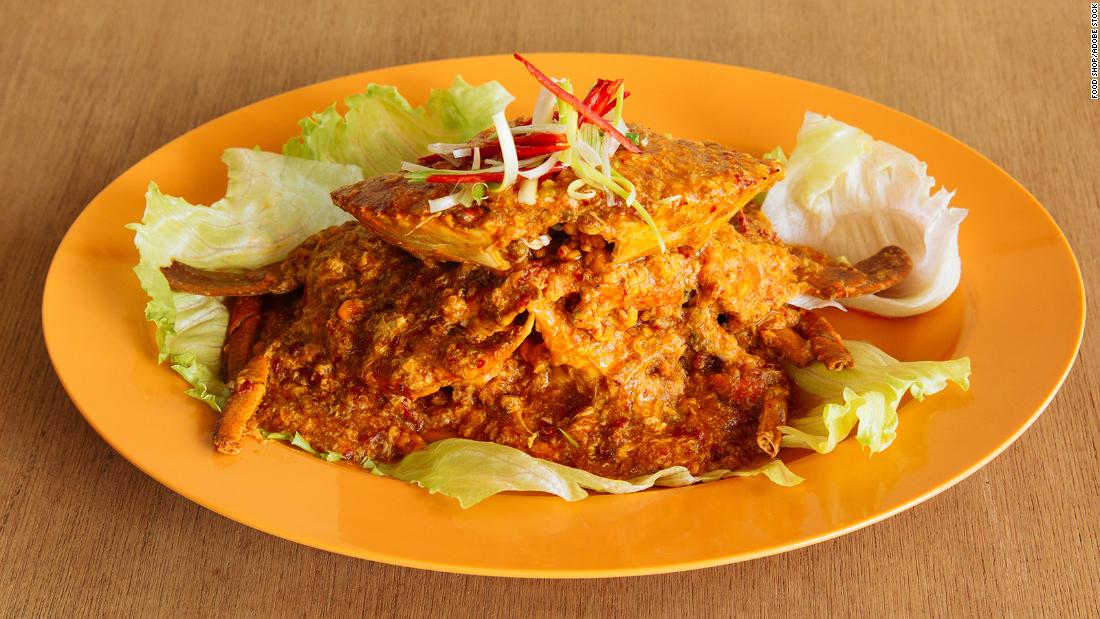(CNN) — Bubbling cauldrons of noodle soup, flaky flatbreads, kaleidoscopic desserts — when it comes to street food, Asia delivers big on variety and flavor.
This vast region sprawls across equatorial tropics and mountain ranges, volcanic islands and frenetic megacities, so it’s no surprise that diversity abounds.
Yet there are many similarities, too. With centuries of migration and trade, many recipes have traversed borders only to become a local specialty thousands of miles from their places of origin.
To celebrate the region’s bottomless culinary talent and passion for food, we’ve rounded up 50 must-try, much-loved street foods and beverages in Asia in alphabetical order.
Of course, this list is far from exhaustive — it’s just a small sampling of the region’s wonderful food traditions and where to find them.
Let’s dig in.
Achcharu, Sri Lanka
Pickles get a Sri Lankan twist with achcharu — sweet, sour and spicy pickled fruits and vegetables that make a perfect street-food snack.
Seasoned with local spices, chili, turmeric, sugar and salt, the offerings will differ depending on the region and seasons — it might be Ceylon olives (veralu), wood apple, pineapple, ambarella, mango, jackfruit or eggplant.
Asam laksa, Malaysia
Sometimes, a big, delicious bowl of soup just hits the spot. Sate cravings with a local specialty: asam laksa.
Thought to have originated on the coast, the fish-based soup has a sour, tamarind flavor that’s surprisingly refreshing even on hot, humid mornings.
A typical bowl arrives brimming with rice noodles, vegetables, shredded fish and coriander and with a side of Malaysian shrimp paste.
Banh mi, Vietnam
The French may have introduced baguettes to Vietnam, but the country’s famed banh mi is a uniquely Vietnamese creation.
Like many foods on this list, the ingredients will vary from north to south and east to west.
Still, a classic combination includes pork, pickled vegetables, coriander, chili and a healthy smear of pâté sandwiched by a crispy, fluffy baguette.
Bubble tea, Taiwan
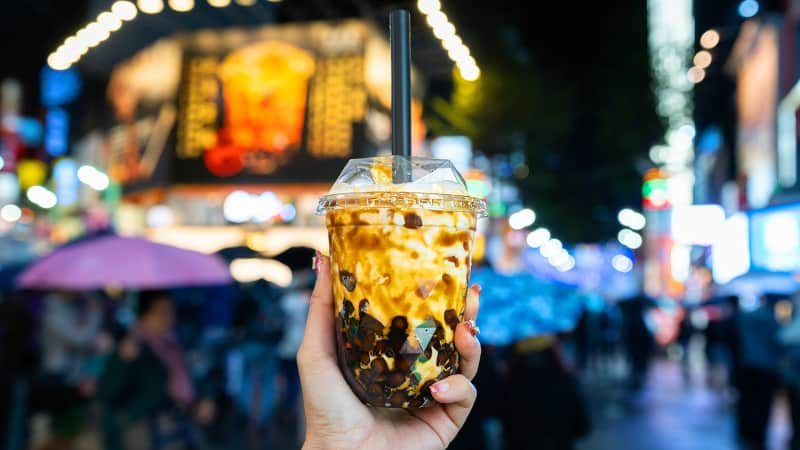
Now globally famous, bubble tea was invented in Taiwan.
tawatchai1990/Adobe Stock
No trip to Taiwan would be complete without at least one bubble tea. Also known as boba or pearl milk tea, this famous Taiwanese export has garnered a worldwide following.
Invented in Taiwan in the 1980s, the classic recipe calls for rich, silky, shaken green or black tea with sizable black tapioca balls, which require a special straw to drink.
These days, many imaginative flavors (Oreo! Sweet potato! Matcha! Kumquat!) just beg to be sampled, and many vendors let diners customize elements like sugar and ice.
Bun kebab, Pakistan
How can you go wrong with a kebab patty between two seared buns?
Easy to find at roadside stalls all over Karachi and Lahore, these delectable Pakistani burgers often come with a potato-lentil patty, although chicken, mutton, beef and chickpea varieties are also common.
Depending on the vendor and region, your bun kebab may also come topped with red onions, tomatoes, raita (a spiced yogurt dip) and tamarind chutney.
Cheong fun, Hong Kong
For classic street food favorites, including delicious cheung fun, head for the bustling neighborhood of Sham Shui Po.
Meaning “intestine noodles”, cheong fun is a staple street snack and dim sum favorite. But contrary to the name, the dish doesn’t actually feature entrails. (The moniker refers to the tubular shape.)
A thin and translucent rice roll is steamed and folded, then filled with char siu (Chinese barbecued pork), dried shrimp, beef or vegetables.
A few sauces — soy, hoisin, peanut and chili — and a crown of sesame seeds complete this must-try dish.
Chili crab, Singapore
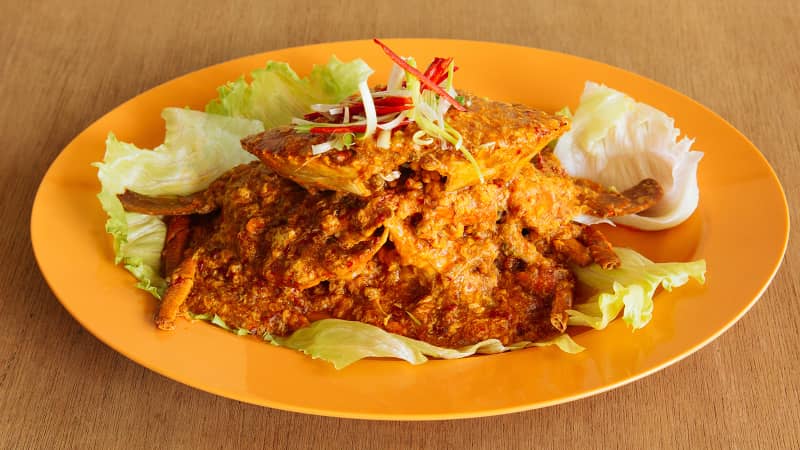
Singapore’s chili crab is messy in all the best ways.
Food Shop/Adobe Stock
You can find chili crab in many hawker centers and specialty restaurants these days but this iconic dish got its start on the streets of 1950s Singapore in a pushcart.
It is messy in all the best ways — and if you don’t get your hands dirty cracking mud crab legs, then you’re not doing it right.
After excavating the crab meat, scoop up the rich chili-tomato sauce with buttery fried mantou buns.
Crab omelets, Thailand
Chef “Pom” Kwantip Devakula of “MasterChef Thailand” shows Richard Quest her favorite authentic Thai recipe.
After you’ve had a kai jeow pu (a Thai crab omelet), it’s hard to understand why all egg dishes don’t taste this good.
Crab and eggs are a match made in heaven — and the crispy edges, fluffy texture and a drizzle of sweet chili sauce takes this wok-cooked dish to the next level.
Curry fish balls, Hong Kong
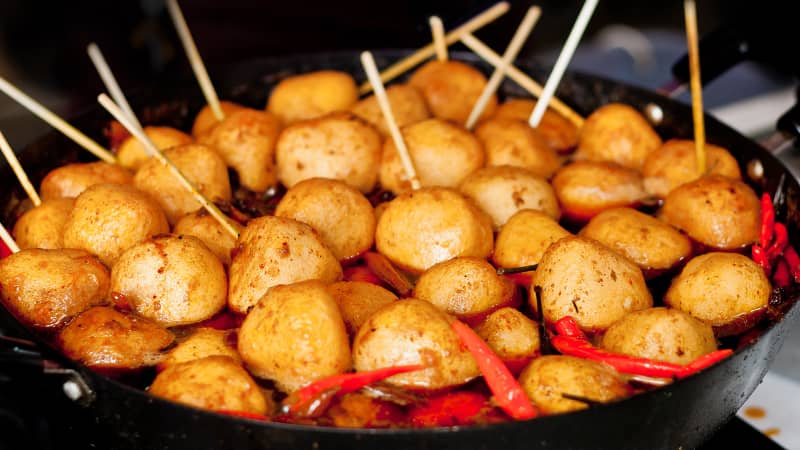
Hong Kong’s curry fish balls are known for their rich, robust flavor.
YiuCheung/iStockphoto/Getty Images
Fish balls — ping-pong-sized spheres of shredded and pounded fish — are among the most beloved street snacks in Hong Kong.
One quintessential variety, curry fish balls, will definitely inspire cravings long after the first bite.
Simmered in curry sauce, garlic, ginger, sugar and chili, these street snacks are known for their rich, robust flavor.
Enjoy them on bamboo skewers or in a cup while exploring the city’s vibrant neighborhoods.
Ema datshi, Bhutan
You can’t go to Bhutan without embracing the country’s penchant for all things cheesy, spicy and fresh.
Another local favorite is ema datshi, which just so happens to be the country’s national dish.
This spicy stew, meaning “chili and cheese”, showcases Bhutan’s glorious local cheese and produce.
Though it’s everywhere, you’ll never get bored: ema datshi comes in many variations, though most are very spicy and served with onion, garlic and red rice.
Egg waffles, Hong Kong
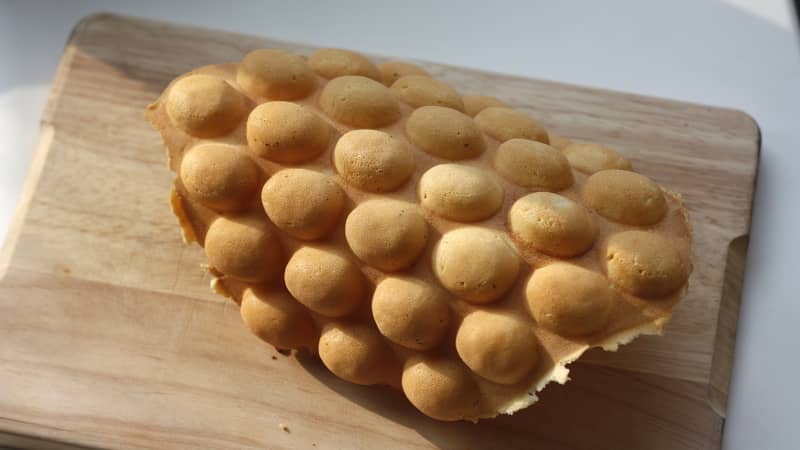
Hong Kong’s egg waffles are crispy on the outside, while each “bubble” is fluffy on the inside.
Maggie Wong
An easy, one-handed snack, gai daan jai (egg waffles, egg puffs or eggettes) is the ideal street food.
A light, slightly sweet batter requires a special waffle maker with round cells to create a puff-like appearance, crispy exterior and airy interior.
Experimentation is part of the fun: Enjoy it plain, with fresh fruit, or rolled into a cone and covered with ice cream, syrup and bananas. Some vendors even go the savory route, serving flavors like salted egg yolk and seaweed.
Falooda, Pakistan
As delicious as it is photogenic, falooda will keep you cool during Pakistan’s scorching summers.
Akin to an ice cream sundae, this milk-based drink is made up of ice cream or kulfa (a dense, gelato-like ice cream), milk, condensed milk, jelly cubes, noodles, basil seeds and sometimes rose water syrup to achieve a bright, rosy pink hue.
A crown of crushed pistachios and dried fruit add more texture, so this dessert is at once smooth and crunchy and both sweet and cooling.
Fuchka, Bangladesh

These crispy, hollow spheres are just as delicious as they look.
Tarun/Adobe Stock
A little bit sweet, a little sour, a little spicy, fuchka (a Bangladeshi version of what’s known as panipuri, gol gappa, gupchup, among other monikers in India) is one of the most ubiquitous street foods in Bangladesh.
The crispy, hollow spheres commonly come with a filling of mashed potatoes and chickpeas, mixed with freshly chopped onions, cucumber, lime, coriander and green chillies in a chaat masala blend.
Before serving, vendors often grate boiled eggs on top as a garnish. Usually, you’ll also receive a small cup of tamarind water sauce to pour inside the shells to enhance that sweet, tangy and spicy flavor that tantalizes all of your taste buds.
Gado gado, Indonesia
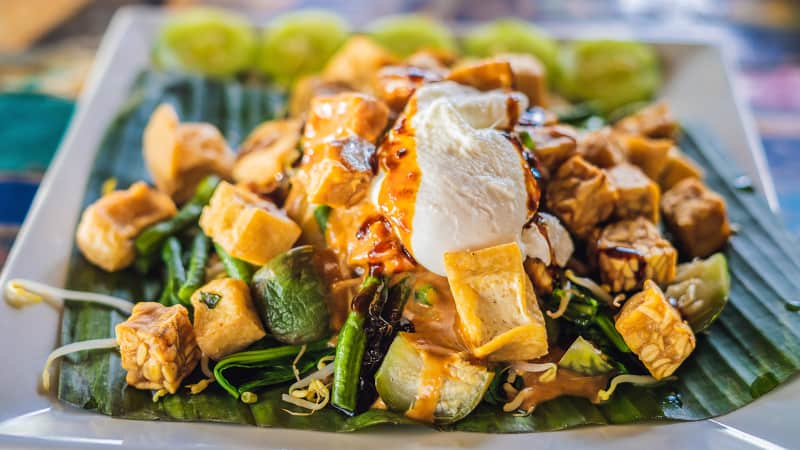
Gado gado features a mix of veggies in a thick, peanuty sauce.
galitskaya/Adobe Stock
Healthy and hearty, gado gado (meaning “mix-mix”) tosses together a garden of vegetables and tasty ingredients in a thick, peanutty sauce.
While the recipe varies depending on the vendor, it’s common to see green beans, cabbage, carrots, bean sprouts, lettuce, tofu, cucumbers, tempeh, potatoes, a hard-boiled egg, and sides of lontong (rice cakes) and prawn crackers.
Getuk, Indonesia
It’s impossible to walk by this eye-catching, brightly-hued dessert without stopping for a sample.
There are countless variations of getuk (or gethuk) on offer, from cassava (a nutty, starchy root vegetable) with coconut to yam, potato, banana, taro or cheese.
Halo-halo, Philippines
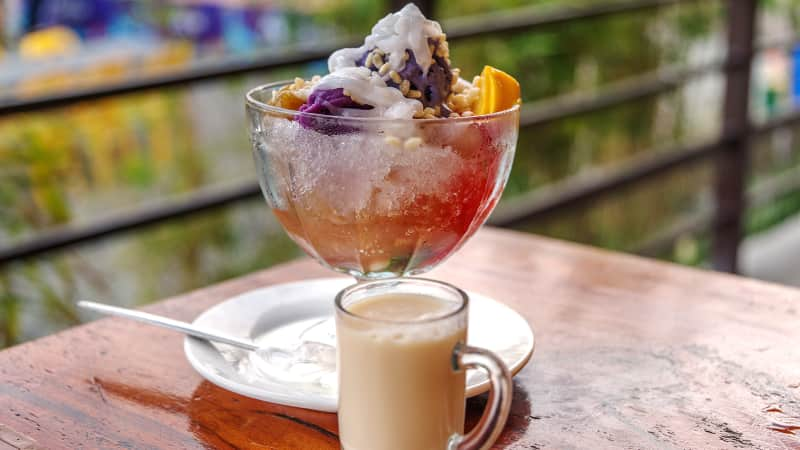
Halo-halo is famed for its colorful toppings.
bugking88/Adobe Stock
A mountain of crushed ice and condensed milk with a rainbow of toppings, halo-halo (also haluhalo, meaning “mixed” in Tagalog) is the perfect antidote to the Philippines’ hot and humid summers.
While it varies across the country, the long list of ingredients may include the likes of cubed yam, taro, coconut flakes, tapioca pearls, flan, sweetened beans, plantain, jackfruit, coconut jelly, nuts, sago, cheese, ice cream, ube (purple yam), toasted rice…the list goes on.
The crunchy, crispy, chewy, creamy textures are just as diverse, making this one dish that lives up to its name.
Hoppers, Sri Lanka
Wake up and smell the appa (also called aapa or appam) in Sri Lanka!
Thought to have originated over in southern India 2,000 years ago, appa, or hoppers, are made from fermented rice flour and coconut milk batter cooked like a crêpe in a small wok.
This method creates a bowl-like shape that’s slightly thicker and spongier at the bottom while staying crispy on the edges.
Plain hoppers and egg hoppers (a plain hopper with a soft-boiled egg in the middle) typically come with chutney, coconut sambal and often a range of curry dishes.
Iced coffee, Vietnam
Would you like some eggs with your coffee? In Hanoi, ca phe trung — or egg coffee — is a local favorite.
Served by street vendors and cafes alike, cà phê, as it’s known in Vietnam, can be enjoyed many ways — drink it black, with condensed milk, a touch of sugar or mixed with coconut milk.
Sit down and make new friends on a plastic stool or keep exploring with your chilled refreshment in hand.
Jalebi, India
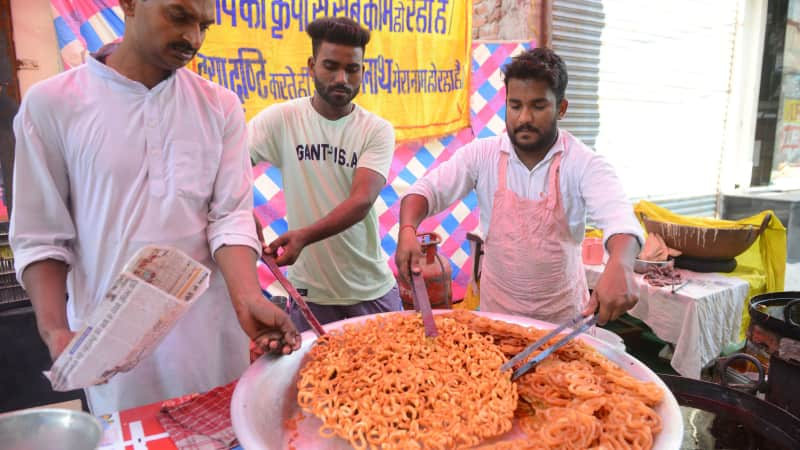
In Northern India, jalebi — batter fried into swirling shapes — are a beloved sweet, especially when paired with condensed milk and topped with spices.
NARINDER NANU/AFP/AFP/Getty Images
Don’t be surprised if you have to wait in line for jalebi, a bright orange funnel cake dipped in simple syrup and often spiced with saffron.
Best enjoyed fresh from the fryer or chilled, these concentric swirls of deep-fried fermented batter taste crispy, juicy and exceptionally sweet, while a side of rabri (a condensed milk dish) or curd can help cut through the sugar.
And thanks to their versatility, jalebi make for a delicious breakfast, accompaniment to chai (tea) or after-dinner treat.
Jianbing, China
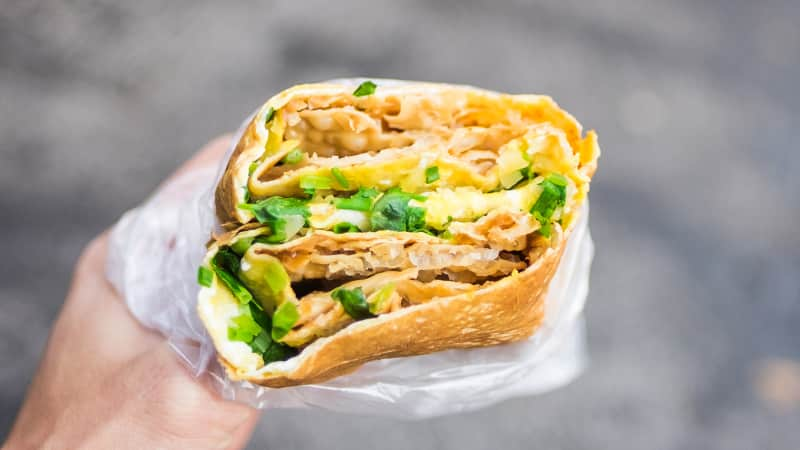
Savory, crispy crepes? Yes, please.
Larry Zhou/iStockphoto/Getty Images
Chinese street food vendors have mastered breakfast with this crepe-like creation.
Perfect for on-the-go snacking, vendors fry the pancake then fill it with a variety of savory flavors — think eggs, spring onions, radishes, chili sauce and sausage or chicken.
The best part? The crispy bao cui, or fried crackers. Having originated in northeastern China, jiangbing have spread across the country with different variations depending on the region.
Jiaozi, China
Dumpling fans will love Chinese jiaozi.
Whether steamed, boiled or pan-fried to perfection, these delightful crescent-shaped morsels are most commonly filled with minced pork, ginger, scallions and Chinese cabbage, though many combinations exist.
Kavaabu, Maldives
In the Maldives capital Male, look for a popular street food called kavaabu (or kavab).
Essentially a deep-fried fish fritter, kavaabu has a super crispy exterior encasing a delicious combination of smoked tuna, shredded coconut, peppers, onions, lentils, ginger, rice and curry leaves.
Kaya toast, Singapore/Malaysia
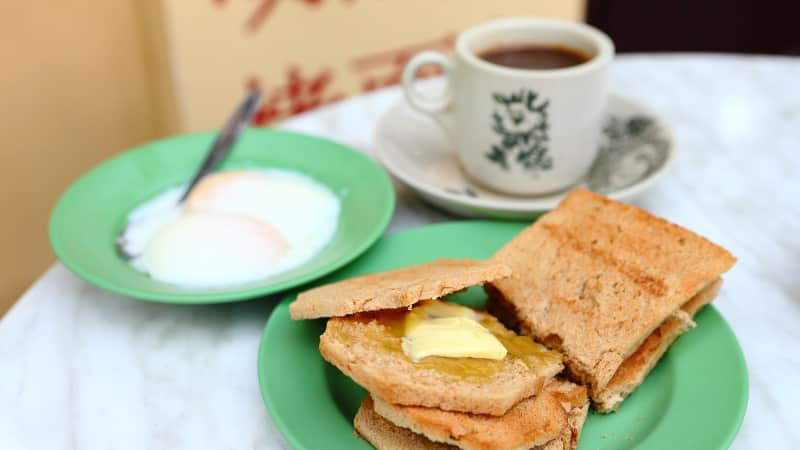
Kaya toast: A breakfast sandwich with aromatic jam.
Singapore Tourism Board
Can’t decide between a sweet or savory breakfast? Enter kaya toast: a charcoal-kissed breakfast sandwich that’s nothing short of a daily ritual in both Singapore and Malaysia.
It’s insanely delicious thanks to the kaya — an aromatic jam made from coconut milk, eggs, sugar and pandan.
Enjoy it with soft-boiled eggs for dipping or eating separately with a dash of dark soya sauce, and a cup of thick kopi (Nanyang coffee) or milk tea will complete this quintessential experience.
Kerak telor, Indonesia
If you think you know omelets, think again.
Cooked over charcoal, kerak telor (meaning “egg crust”) is a traditional Betawi dish that bursts with flavor and texture thanks to ingredients like duck eggs, glutinous rice, grated coconut, fried shallots, dried shrimp and Indonesian spices.
Khao jee, Laos
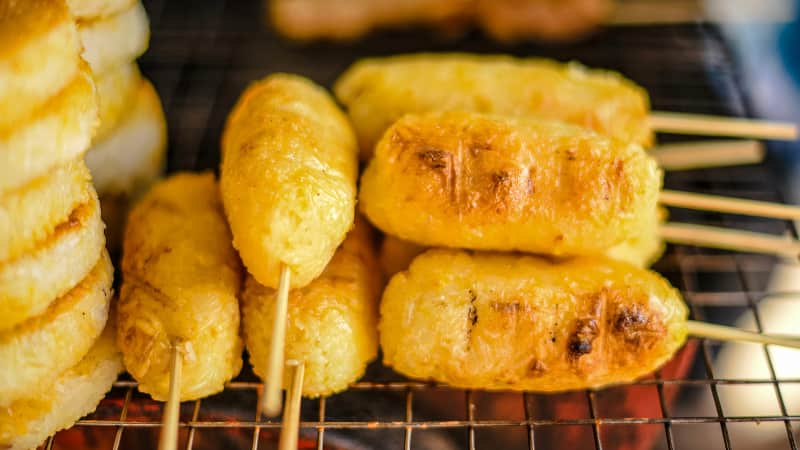
Khao jee: Sticky rice coated with eggs and grilled over a charcoal stove.
Chay/Adobe Stock
It looks simple — a grilled sticky rice patty on a stick — but there’s more to this street food staple than meets the eye.
Thanks to a thin egg coating and a light char from the grill, khao jee has a radiant golden hue, a sweet and nutty flavor, and a delightfully chewy texture.
As a happy coincidence, another fantastic street food shares the same name: khao jee pâté (a Lao-style baguette sandwich, similar to a Vietnamese banh mi) filled with pork liver pâté, pickled carrots, cucumber, papaya and a local chili paste called jeow bong.
Khao soi, Thailand

Warning: This northern Thailand dish is insanely addictive.
kobozaa/Adobe Stock
A staple in Northern Thailand, khao soi — curry noodle soup topped with deep-fried egg noodles — hits the spot.
Vendors ladle gorgeously golden bowls of hearty, creamy, chili-laced coconut broth over a bed of egg noodles with chicken legs or beef.
On the side, you will often find mustard greens, freshly chopped shallots, lime wedges and chili paste.
Khuushuur, Mongolia
Exploring the Mongolian steppes will surely work up an appetite, but luckily khuushuur, Mongolia’s beloved street snack, provides a hearty, filling meal.
Enjoy the large, deep-fried meat pastry (usually filled with minced mutton or beef, onion and garlic) with a cup of Mongolian tea.
Kimbap, South Korea

Kimbap are filled with all sorts of ingredients.
yooranpark/Adobe Stock
Kimbap, or gimbap, seems like it was designed to be portable.
Not unlike Japan’s makizushi (rolled sushi), these rice rolls wrapped in seaweed sheets are cut into easy-to-devour slices that hawkers fill with a wide assortment of ingredients.
Spinach, lotus root, eggs, cucumbers, bulgogi and crab sticks all make regular appearances, as do pickled daikon radish, kimchi and roasted sesame seeds.
Kuih cincin, Brunei
In Brunei, kuih cincin (meaning “ring cakes”) makes for a delicious after-dinner treat.
This photogenic, cookie-like dessert is easily identifiable thanks to its flower-like appearance. It tastes as good as it looks, with a sweet, nutty flavor and a satisfying crunch.
Kwek kwek, Philippines
Next time you’re in the Philippines, try kwek kwek — deep-fried quail eggs. They owe their radiant orange hue to annatto powder in the batter.
Slightly peppery, sweet and nutty, the citrus-hued powder comes from the prickly fruits of the achiote tree, though some vendors use orange food coloring for a similar effect.
After a bath in the orange batter, the hard-boiled eggs dive into the deep fryer before landing on a plate with a sour and spicy dipping sauce.
Laping, Tibet, China
A summer specialty in Tibet, laping (or laphing) is a spicy noodle dish that’s served chilled.
The soup explodes with flavors and textures thanks in part to thick, jelly-like noodles made from mung beans and a fiery sauce made with lots of red pepper.
Lahpet thoke, Myanmar
Tea leaf salad, known locally as lahpet thoke, has an earthy, sour and slightly bitter taste, owing to the star ingredient: fermented or pickled Assam tea leaves.
The tea leaves are then mixed with cabbage, tomatoes, beans, roasted nuts, toasted seeds, dried shrimp and fried garlic for a salad that’s loaded with textures and aromas.
Lort cha, Cambodia
Nothing hits the spot like a stir-fried noodle dish, and Cambodia’s go-to variety is no exception.
Typically prepared in street carts and markets, lort cha features short and squat rice pin noodles tossed with spring onions, Chinese broccoli, crunchy bean sprouts, chives, garlic and beef then topped with a fried egg and a special sauce.
Generous lashings of Cambodian fermented red chili paste enhance the spice level, which vendors are all too happy to dial up for you.
Mohinga, Myanmar
Snag a seat at a street food stall bright and early — or really, any time of day — to enjoy a steaming bowl of mohinga (fish noodle soup).
The country’s de facto national dish combines a beautiful balance of fresh catfish and lemongrass, toasted rice, ginger, garlic and springy rice noodles cooked to order with a range of optional toppings.
Top it off with a hard-boiled egg, fried onions, cilantro and a squeeze or two of lime for a rich yet bright meal.
Momos, Nepal

Momos are among Nepal’s most popular dishes.
jenni marsh
If you’ve tried just one food from Nepal, it’s most likely momos.
Region to region, family to family, no two recipes will be identical.
Generally speaking, these delicate dumplings enclose different types of minced meat — buffalo, chicken, mutton, yak, or pork — with seasonings, like cabbage, onion, spring onion, ginger, garlic, tamarind, coriander and spices.
Nam khao, Laos
While nam khao (crispy rice salad) can also be found in Thailand, the bright and refreshing dish is thought to have originated in Vientiane, the Laos capital.
It’s a balancing act of brilliant flavors, aromas and textures starring crispy deep-fried rice balls made with a base of red curry paste, coconut flakes and egg.
The fried rice is then crumbled up and mixed with sausage, tempura, peanuts, onion, chili and more, and served with fresh lettuce leaves.
Nasi lemak, Malaysia
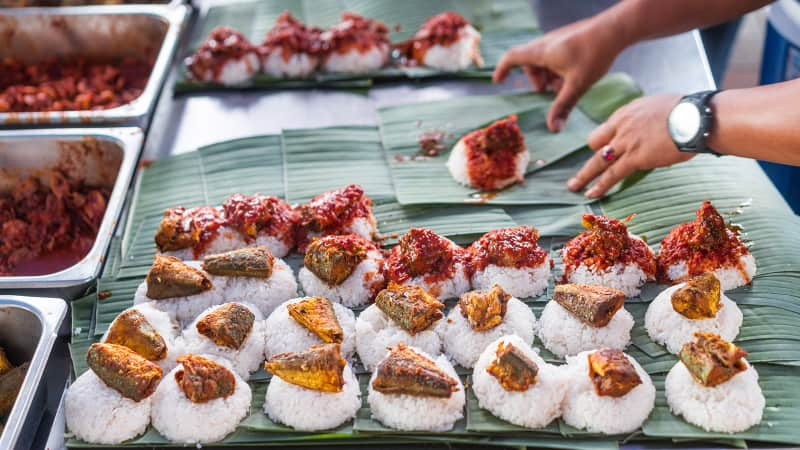
Nasi lemak features a variety of ingredients set on a bed of coconut rice.
John/Adobe Stock
For Asian food lovers, nasi lemak needs no introduction.
It’s Malaysia’s national dish for a good reason: this delicious spread tantalizes taste buds with a bed of coconut rice topped with salty anchovies, roasted peanuts, boiled eggs, cucumbers, and sambal served hot and steamy in a fragrant banana leaf.
Variations abound, with some vendors adding fried chicken or a side of curry, fish or fried eggs.
Pho, Vietnam
Few street foods can compete with the international fame of pho.
Roadside stalls and cafes serve up bowl after bowl of this hearty noodle soup, which is known for its aromatic and nuanced broth, springy rice noodles and tender protein (usually beef or chicken).
It’s typically served alongside a selection of fresh garnishes, like herbs, bean sprouts, lime, chili sauce and chili slices so you can tailor the noodle soup to your liking.
Rojak, Malaysia/Indonesia/Singapore
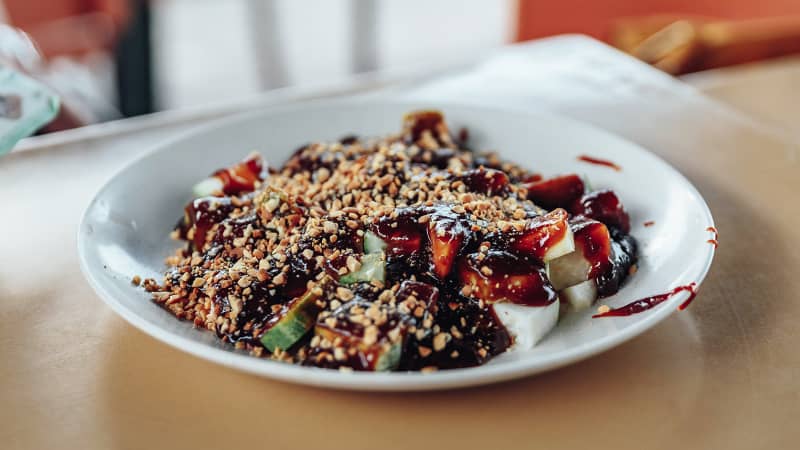
Rojak is a traditional fruit and vegetable salad dish.
artitwpd/Adobe Stock
Rojak (or rujak), which originated in Java, Indonesia, can be found all over Malaysia and Singapore, too.
The tangy and spicy salad embodies the Southeast Asian sunshine, bringing together a jumbled mix of fresh fruit like pineapple and mangoes, jicama (a root vegetable), bean sprouts, cucumbers, fried tofu, and other additions — all tossed in a thick, sweet and spicy dressing (almost like the consistency of caramel or mole sauce) and a sprinkle of crushed peanuts.
Roti prata, Southeast Asia
It’s always a good time for some roti prata.
Tracing its roots to India, this golden-brown, flaky flatbread is a staple in Singapore, Malaysia and many other countries in Southeast Asia.
Available in abundance at hawker centers, food courts, coffee shops and restaurants, ghee-flavored roti prata is perfect in its traditional iteration of plain or egg with fish or mutton curry, but can also serve as the canvas for dozens of creative and modern combinations — think flatbread with fish or mutton curry, ham, egg, cheese, chocolate, bananas, ice cream or even durian.
Rou jia mo, China
Take a dense, chewy mo (bun), add a mountain of pork belly braised in soy sauce, rock sugar, herbs, plus a dozen or so spices (think cardamom, Sichuan peppercorns, cloves, bay leaf, and star anise), and you’ve got yourself a rou jia mo (also known as a Chinese hamburger).
It’s said that the bread dates to the Qin dynasty followed by the meat in the Zhou dynasty, so this recipe has obviously stood the test of time.
Sai krok Isan, Thailand
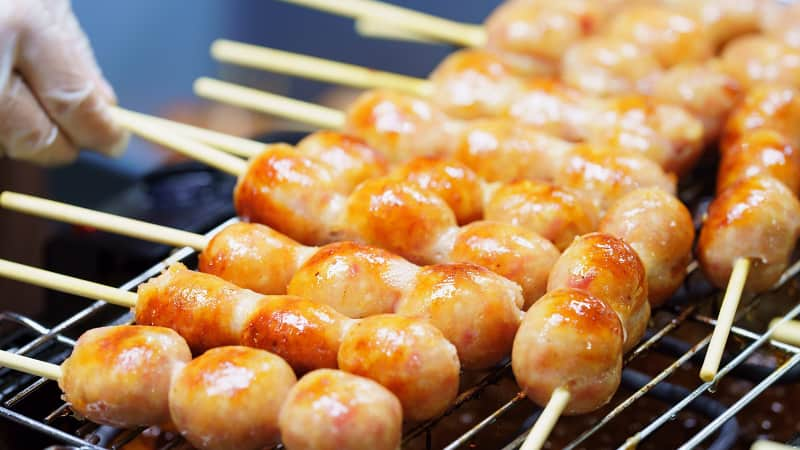
Though from the northeast, sai krok isan can be found all over Thailand.
korrakot sittivash/Adobe Stock
Sai krok Isan — short and plump pork sausage — is one of the most commonly devoured street foods in northeastern Thailand.
Sour and garlicky, it’s usually made from pork, sticky rice and garlic, then hung up to ferment and dry.
Herbs and spices vary from vendor to vendor, while condiments like ginger, chillies and cabbage typically round out the perfect bite.
Salt & pepper fried chicken, Taiwan

Popcorn chicken is the ultimate Taiwanese snack.
uckyo/Adobe Stock
Taiwan’s multitude of street foods are famous for their flavors and textures — and salt and pepper fried chicken, also known as popcorn chicken, is a case in point.
Coated in sweet potato flour then double-fried to add crunch and lock in moisture, this street food is easy to eat while wandering through the island’s famous night markets.
Sofuto kurimu, Japan
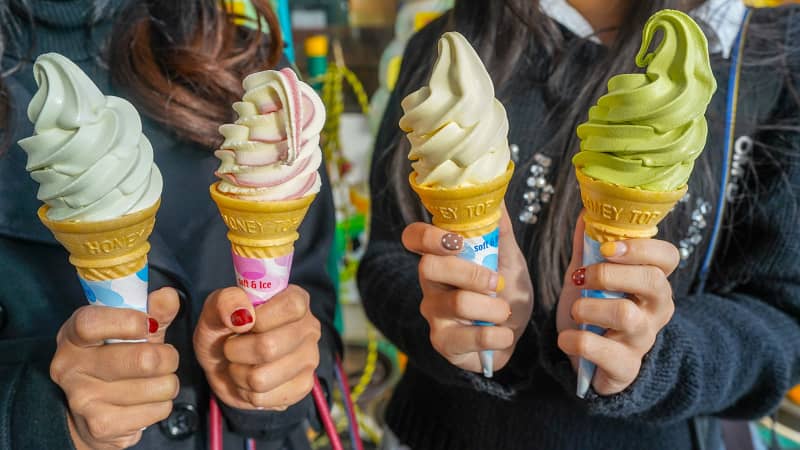
Sofuto kurimu is famed for its silky texture.
Danupol/Adobe Stock
Smooth, creamy and available in a rainbow of flavors, Japanese sofuto kurimu (or soft cream, which is akin to soft serve) is in a league of its own.
Made with fresh cream and milk, sofuto kurimu has an impossibly silky texture that melts in your mouth. Try a classic chocolate and vanilla swirl, or try special regional flavors like charcoal, ube (purple sweet potato), matcha, red bean, melon, sesame, wasabi or even squid ink depending on the locale.
Stinky tofu, Taiwan
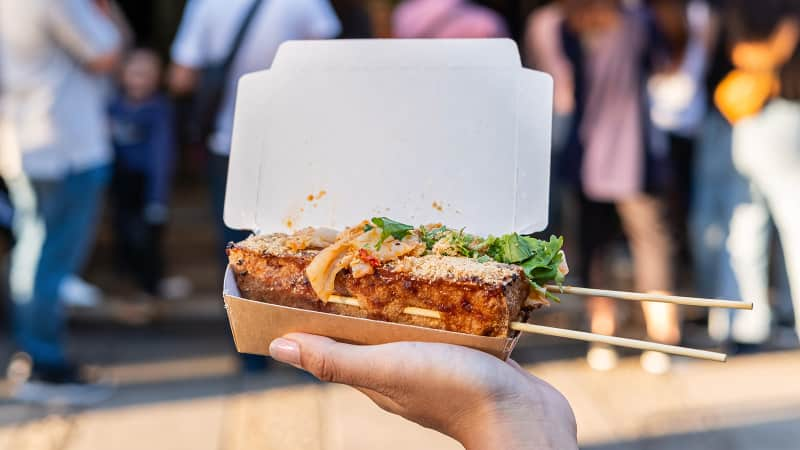
Don’t let the name put you off. Stinky tofu is delicious.
Kittiphan/Adobe Stock
The pungent aroma that stinky tofu (chou dou fu) is known for comes from the fermentation process.
Essentially, vendors soak bean curd in brine, then let it ferment for hours, days, weeks or months at a time.
Once it’s ready, street food hawkers stew, braise, steam, grill, or deep-fry the tofu then dress it up with tasty additions like pickled cabbage, chili sauce or garlic sauce.
Takoyaki, Japan
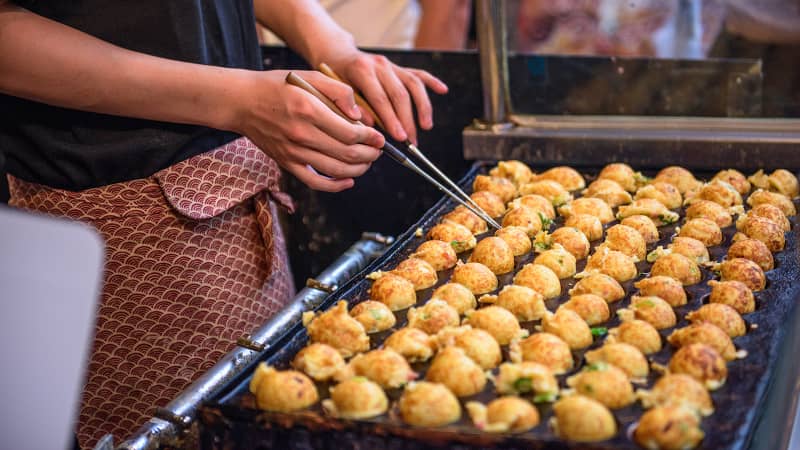
Takoyaki being prepared at a foodstall in Osaka, Japan.
SeanPavonePhoto/Adobe Stock
Springy, chewy, salty, juicy… there’s much to love about Japan’s famous takoyaki (octopus balls), which hail from Osaka.
To make takoyaki (“tako” means octopus and “yaki” means roast), vendors whip up the batter, pour it into a special iron and evenly disperse the fillings (diced octopus, spring onion, tempura flakes).
To ensure they cook evenly and form perfect spheres, cooks skillfully turn them over one by one with a bamboo skewer. Once ready, a drizzle of Japanese mayonnaise, takoyaki sauce, seaweed flakes and bonito (fish flakes) adds texture and flavor.
Tteokbokki, South Korea
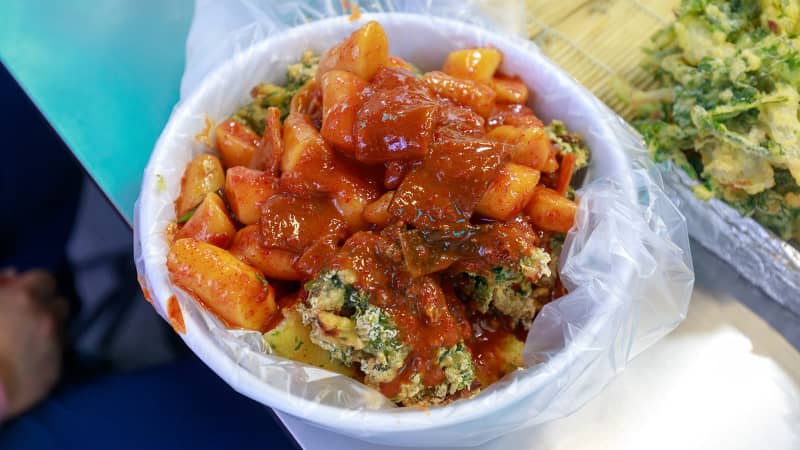
Tteokbokki, stir-fried rice cakes, are a popular Korean street food.
artran/iStockphoto/Getty Images
The humble rice cake is a much-loved comfort food in South Korea — and it’s easy to see why.
Tteokbokki, meaning “stir-fried rice cakes,” are incredibly versatile; the most famous variation stars spicy red chili paste and fish cakes, but rice cakes can also be prepared with a milder soy sauce-based dressing, with cheese, or in various soups and hot pots.
Vada pav, India
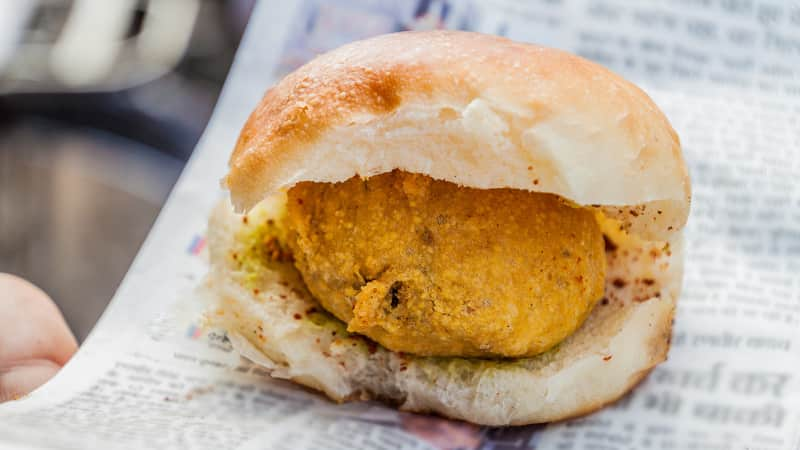
Vada pav: Deep-fried potatoes on a fluffy bun.
Matyas Rehak/Adobe Stock
You can’t go far in Mumbai without encountering the spiced aroma of a masala chai or the sound of a bubbling fryer.
For a surefire crowd-pleaser, it’s hard to go wrong with vada pav — deep-fried spiced potatoes with tamarind paste, chili pepper and various chutneys on a fluffy pav (or bun).
Xiao long bao, China
Nothing really compares to your very first xiao long bao (meaning “little basket buns”).
One of the most delicious dishes on Earth, these tiny bite-sized soup dumplings are a Shanghainese specialty.
Each delicate, carefully folded parcel contains piping hot broth and a ball of ground pork.
Order at least a half-dozen more than you think you want — they won’t go uneaten — and enjoy it with a dipping sauce made of vinegar, soy sauces and fresh ginger.
Yakitori, Japan
A crash course in yakitori from the head chef at popular Tokyo restaurant Torikado.
In Japan, you’ll find no shortage of shichirin (small charcoal grills) sizzling up squid, fish, quail eggs and mushrooms, but one specialty stands out: yakitori, or grilled chicken (“yaki” meaning grilled or cooked over direct heat, “tori” meaning bird) skewers.
And we’re not just talking about wings: typical menus typically include chicken thighs, breasts, kidneys, gizzards, skins, livers and hearts cooked slowly over binchotan (white charcoal), then sprinkled in salt or glazed with a soy-based sauce called “tare.”
